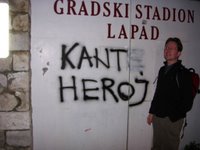Summary of: Tesanovic, Jasmina.
The Diary of a Political Idiot: Normal Life in Belgrade. San Francisco: Midnight Editions, 2000.
Life in Belgrade during NATO bombing was both terrifying and monotonous for Jasmina Tesanovic, author of
The Diary of a Political Idiot. Unlike the wartime diary of Anne Frank, Tesanovic’s writing reflects a new kind of war, one voiced by an adult with children of her own. This new war unfolds on BBC and CNN, watched by those inside Belgrade, where they learn of air strikes within their city, bemused when the foreign news gets the story wrong. Following the trajectory of Yugoslavia into war, Tesanovic’s diary takes the reader inside the city and appeals to the outside for understanding.
The diary follows the inner thoughts and outer activities of Tesanovic from 1998 to 1999; she is mother, daughter, wife, friend, writer, and filmmaker. Even before NATO reprisals begin, Tesanovic struggles with the multiple roles she plays; her fatalism, rationale for writing in English, the guilt she feels as a child of communists, and the unbridgeable divide between Tesanovic and her parents are detailed in entries. By revealing her conflicting emotions and sharing the small moments that make up a large part of life, Tesanovic’s diary provides a compelling connection, to her and therefore to Serbians, the group despised for bringing about this war.
Tim Judah’s introduction supplies a helpful background to Balkan events in the 1990s. Threaded throughout his lengthy introduction, however, are various restatements of the idea that the diarist, Ms. Tesanovic, is just like us. She is one of us, or could be us. These several heavy-handed statements detract from the real story, the entries shared by the author.
Arguably the diary is set in three acts, not parts: Prelude, NATO, and Political Idiots. The idiots of the title and chapter reference the Greek roots of idiot: “a common person without access to knowledge and information” (Tesanovic, 2000, 39). Tesanovic writes that she and the majority of Serbs are political idiots, caught up by their corrupt leadership. The Prelude is full of talk of sanctions, comparisons to the earlier wars in Croatia and Bosnia, and plans to leave. NATO focuses on life during the air strikes: belated attempts to obtain a passport and VISA, worried thoughts about Albanian friends in Kosovo, meetings with friends or protest groups, reflections on her parents and their disapproval, runs to the shelter for cover and runs to the black market for food, and always the worry and second-guessing of choices made. Political Idiots turns towards the ending of the bombing, the signing of a peace agreement, the apprehension of a new regime, and acknowledging Serbs are no longer able to hide as idiots.
The diary’s strengths lie in writing about the events that everyone already knows about war and detailing its minutia. Rumors run emotions. Neighbors and neighborhoods are forcibly knit together as bridges are targeted for bombing and citizen mobility is restricted by gas rations and blockades. More weddings take place. The rush to underground shelters as the sirens blast, reminiscent of WWII film, is followed by the gradual inurement of the citizens to the sirens, to the war. Now, the eeriness of phone calls from the field. The portrayal of life during a modern war, and how people become trapped in their own lives, is a jarring juxtaposition of us and them.
Throughout her diary, Tesanovic seems to address us, the NATO countries, trying to show that the people of Serbia are not wild, bloodthirsty, and warlike, no matter what decisions their leaders make. Serbs want to eat in restaurants, drink wine on the terrace, and enjoy the company of friends. Already filming a version of this diary while still writing it, Tesanovic shows the hope that still exists, whether her words express it or not, that Serbia and she will survive the war, that she has not waited too long, that staying in the city was the right choice. ~ Amy Fyn























